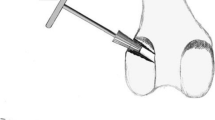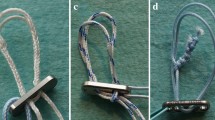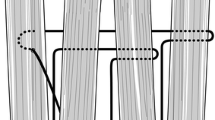Abstract
Introduction
In ACL reconstruction using a soft tissue graft, aperture fixation with interference screws (IFS) can lacerate and rotate the graft and cause primary tunnel widening. To overcome these downsides, a new wedge-shaped implant (MegaShim, Karl Storz, Germany) was developed. We hypothesized that aperture fixation of hamstring ACL reconstruction using the MegaShim technique shows comparable structural properties when compared to interference screw fixation.
Methods
In a porcine knee model, ACL reconstructions with a tunnel diameter of 6, 7, 8 and 9 mm were performed and human hamstring grafts were fixed using the MegaShim technique (group I). In group 2, grafts were fixed in a hybrid fixation using a MegaShim and cortical flip button (FlippTack, Karl Storz, Germany). Interference screw graft fixation served as a control group (group III). Maximum load, yield load and stiffness were recorded using material testing machine. Grafts were cyclically preconditioned between 0 and 20 N for 10 cycles before the graft–bone complex was loaded to failure. Statistical evaluation was performed using SPSS Version 11.0.
Results
Mean maximum load to failure for the hybrid fixation was significantly higher than after interference screw or MegaShim fixation. The difference between MegaShim and interference screw fixation showed no significant difference for 6 and 7 mm sizes. An 8 and 9 mm MegaShim fixation resulted in significantly lower ultimate failure load compared to interference screw fixation. Stiffness of grafts fixed using 6 mm MegaShim was significantly lower than grafts fixed with hybrid or interference screw fixation, whereas no significant differences were found in the 7, 8, and 9 mm fixations.
Conclusion
Aperture fixation using the MegaShim technique provides comparable structural properties compared to interference screw fixation. Hybrid fixation using MegaShim and cortical flip button results in significantly higher ultimate failure loads than both aperture fixation approaches. Smaller grafts (6 mm) showed significantly lower ultimate failure load and stiffness than interference screw fixation. The “MegaShim technique” is an alternative to interference screw fixation concerning initial fixation strength.




Similar content being viewed by others
References
Corsetti JR, Jackson DW (1996) Failure of anterior cruciate ligament reconstruction: the biologic basis. Clin Orthop Relat Res (325) 42–49
Fu FH, Bennett CH, Ma CB, Menetrey J, Lattermann C (2000) Current trends in anterior cruciate ligament reconstruction. Part II. Operative procedures and clinical correlations. Am J Sports Med 28:124–130
Frank CB, Jackson DW (1997) The science of reconstruction of the anterior cruciate ligament. J Bone Jt Surg Am 79:1556–1576
Blickenstaff KR, Grana WA, Egle D (1997) Analysis of a semitendinosus autograft in a rabbit model. Am J Sports Med 25:554–559
Grana WA, Egle DM, Mahnken R, Goodhart CW (1994) An analysis of autograft fixation after anterior cruciate ligament reconstruction in a rabbit model. Am J Sports Med 22:344–351
Weiler A, Hoffmann RF, Bail HJ, Rehm O, Sudkamp NP (2002) Tendon healing in a bone tunnel. Part II: histologic analysis after biodegradable interference fit fixation in a model of anterior cruciate ligament reconstruction in sheep. Arthroscopy 18:124–135
Brand J Jr, Weiler A, Caborn DN, Brown CH Jr, Johnson DL (2000) Graft fixation in cruciate ligament reconstruction. Am J Sports Med 28:761–774
Hoher J, Scheffler SU, Withrow JD et al (2000) Mechanical behavior of two hamstring graft constructs for reconstruction of the anterior cruciate ligament. J Orthop Res 18:456–461
Hoffmann RF, Peine R, Bail HJ, Sudkamp NP, Weiler A (1999) Initial fixation strength of modified patellar tendon grafts for anatomic fixation in anterior cruciate ligament reconstruction. Arthroscopy 15:392–399
Kurosaka M, Yoshiya S, Andrish JT (1987) A biomechanical comparison of different surgical techniques of graft fixation in anterior cruciate ligament reconstruction. Am J Sports Med 15:225–229
Caborn DN, Urban WP Jr, Johnson DL, Nyland J, Pienkowski D (1997) Biomechanical comparison between BioScrew and titanium alloy interference screws for bone–patellar tendon–bone graft fixation in anterior cruciate ligament reconstruction. Arthroscopy 13:229–232
Kousa P, Jarvinen TL, Kannus P, Jarvinen M (2001) Initial fixation strength of bioabsorbable and titanium interference screws in anterior cruciate ligament reconstruction. Biomechanical evaluation by single cycle and cyclic loading. Am J Sports Med 29:420–425
Liu SH, Kabo JM, Osti L (1995) Biomechanics of two types of bone–tendon–bone graft for ACL reconstruction. J Bone Jt Surg Br 77:232–235
Weiler A, Windhagen HJ, Raschke MJ, Laumeyer A, Hoffmann RF (1998) Biodegradable interference screw fixation exhibits pull-out force and stiffness similar to titanium screws. Am J Sports Med 26:119–126
Becker R, Schroder M, Ropke M, Starke C, Nebelung W (1999) Structural properties of sutures used in anchoring multistranded hamstrings in anterior cruciate ligament reconstruction: a biomechanical study. Arthroscopy 15:297–300
Becker R, Schroder M, Starke C, Ropke M, Nebelung W (2000) Mechanical properties of suture materials for anchoring cruciate ligament transplants. Unfallchirurg. 103:375–379
Hulstyn M, Fadale PD, Abate J, Walsh WR (1993) Biomechanical evaluation of interference screw fixation in a bovine patellar bone–tendon–bone autograft complex for anterior cruciate ligament reconstruction. Arthroscopy 9:417–424
Ishibashi Y, Rudy TW, Livesay GA, Stone JD, Fu FH, Woo SL (1997) The effect of anterior cruciate ligament graft fixation site at the tibia on knee stability: evaluation using a robotic testing system. Arthroscopy 13:177–182
Stadelmaier DM, Lowe WR, Ilahi OA, Noble PC, Kohl HW 3rd (1999) Cyclic pull-out strength of hamstring tendon graft fixation with soft tissue interference screws. Influence of screw length. Am J Sports Med 27:778–783
Woo SL, Hollis JM, Adams DJ, Lyon RM, Takai S (1991) Tensile properties of the human femur–anterior cruciate ligament–tibia complex. The effects of specimen age and orientation. Am J Sports Med 19:217–225
Nebelung W, Becker R, Merkel M, Ropke M (1998) Bone tunnel enlargement after anterior cruciate ligament reconstruction with semitendinosus tendon using Endobutton fixation on the femoral side. Arthroscopy 14:810–815
Rodeo SA, Arnoczky SP, Torzilli PA, Hidaka C, Warren RF (1993) Tendon-healing in a bone tunnel. A biomechanical and histological study in the dog. J Bone Jt Surg Am 75:1795–1803
Giurea M, Zorilla P, Amis AA, Aichroth P (1999) Comparative pull-out and cyclic-loading strength tests of anchorage of hamstring tendon grafts in anterior cruciate ligament reconstruction. Am J Sports Med 27:621–625
Pena F, Grontvedt T, Brown GA, Aune AK, Engebretsen L (1996) Comparison of failure strength between metallic and absorbable interference screws. Influence of insertion torque, tunnel-bone block gap, bone mineral density, and interference. Am J Sports Med 24:329–334
Weiler A, Hoffmann RF, Siepe CJ, Kolbeck SF, Sudkamp NP (2000) The influence of screw geometry on hamstring tendon interference fit fixation. Am J Sports Med 28:356–359
Zantop T, Weimann A, Schmidtko R, Herbort M, Raschke MJ, Petersen W (2006) Graft laceration and pullout strength of soft-tissue anterior cruciate ligament reconstruction: in vitro study comparing titanium, poly-d, l-lactide, and poly-d, l-lactide-tricalcium phosphate screws. Arthroscopy 22:1204–1210
Zantop T, Weimann A, Wolle K, Musahl V, Langer M, Petersen W (2007) Initial and 6 weeks postoperative structural properties of soft tissue anterior cruciate ligament reconstructions with cross-pin or interference screw fixation: an in vivo study in sheep. Arthroscopy 23:14–20
Singhatat W, Lawhorn KW, Howell SM, Hull ML (2002) How four weeks of implantation affect the strength and stiffness of a tendon graft in a bone tunnel: a study of two fixation devices in an extraarticular model in ovine. Am J Sports Med 30:506–513
Herbort M, Weimann A, Zantop T, Strobel M, Raschke M, Petersen W (2007) Initial fixation strength of a new hybrid technique for femoral ACL graft fixation: the bone wedge technique. Arch Orthop Trauma Surg 127:769–775
Weiler A, Richter M, Schmidmaier G, Kandziora F, Sudkamp NP (2001) The EndoPearl device increases fixation strength and eliminates construct slippage of hamstring tendon grafts with interference screw fixation. Arthroscopy 17:353–359
Engebretsen L, Lew WD, Lewis JL, Hunter RE (1989) Knee mechanics after repair of the anterior cruciate ligament. A cadaver study of ligament augmentation. Acta Orthop Scand. 60:703–709
Gibson L, Ashby M (1987) Cancellous bone. In: Gibson L (ed) Cellular solids. Pergamon, New York, pp 316–331
Beynnon BD, Amis AA (1998) In vitro testing protocols for the cruciate ligaments and ligament reconstructions. Knee Surg Sports Traumatol Arthrosc 6(Suppl 1):S70–S76
Shelbourne KD, Gray T (1997) Anterior cruciate ligament reconstruction with autogenous patellar tendon graft followed by accelerated rehabilitation. A two- to nine-year follow-up. Am J Sports Med 25:786–795
Shelbourne KD, Nitz P (1990) Accelerated rehabilitation after anterior cruciate ligament reconstruction. Am J Sports Med 18:292–299
Morrison JB (1969) Function of the knee joint in various activities. Biomed Eng. 4:573–580
Morrison JB (1970) The mechanics of the knee joint in relation to normal walking. J Biomech 3:51–61
Brown GA, Pena F, Grontvedt T, Labadie D, Engebretsen L (1996) Fixation strength of interference screw fixation in bovine, young human, and elderly human cadaver knees: influence of insertion torque, tunnel-bone block gap, and interference. Knee Surg Sports Traumatol Arthrosc 3:238–244
Clancy WG Jr, Narechania RG, Rosenberg TD, Gmeiner JG, Wisnefske DD, Lange TA (1981) Anterior and posterior cruciate ligament reconstruction in rhesus monkeys. J Bone Jt Surg Am 63:1270–1284
Noyes FR, Butler DL, Grood ES, Zernicke RF, Hefzy MS (1984) Biomechanical analysis of human ligament grafts used in knee-ligament repairs and reconstructions. J Bone Jt Surg Am 66:344–352
Scheffler SU, Sudkamp NP, Gockenjan A, Hoffmann RF, Weiler A (2002) Biomechanical comparison of hamstring and patellar tendon graft anterior cruciate ligament reconstruction techniques: the impact of fixation level and fixation method under cyclic loading. Arthroscopy 18:304–315
Weiler A, Peine R, Pashmineh-Azar A, Abel C, Sudkamp NP, Hoffmann RF (2002) Tendon healing in a bone tunnel. Part I: biomechanical results after biodegradable interference fit fixation in a model of anterior cruciate ligament reconstruction in sheep. Arthroscopy 18:113–123
Buelow JU, Siebold R, Ellermann A (2002) A prospective evaluation of tunnel enlargement in anterior cruciate ligament reconstruction with hamstrings: extracortical versus anatomical fixation. Knee Surg Sports Traumatol Arthrosc 10:80–85
Acknowledgments
This study was financially supported by Karl Storz, Tuttlingen, Germany.
Author information
Authors and Affiliations
Corresponding author
Rights and permissions
About this article
Cite this article
Lenschow, S., Herbort, M., Strässer, A. et al. Structural properties of a new device for graft fixation in cruciate ligament reconstruction: the shim technique. Arch Orthop Trauma Surg 131, 1067–1072 (2011). https://doi.org/10.1007/s00402-011-1276-7
Received:
Published:
Issue Date:
DOI: https://doi.org/10.1007/s00402-011-1276-7




